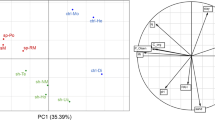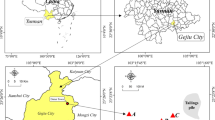Abstract
Purpose
This work aimed to study the effect of long-term polymetallic contamination on the state and parameters of soil bacterial communities, including the abundance of different groups of culturable bacteria and the activity of nitrification.
Materials and methods
Monitoring plots were located in the dry lake and surrounding area, which had been formerly used for the discharge of industrial waste. The soils in the 16 plots were characterized by extremely high levels of heavy metal pollution. This study evaluated the main soil physicochemical properties by various methods, total metal contents by X-ray analysis, mobile metal content by atomic absorption spectrophotometry, the abundance of chosen groups of culturable bacteria by inoculation on solid media, and nitrification activity from ammonium and nitrite oxidation rates.
Results and discussion
High adaptation capacity of microbial communities to long-term pollution was revealed through marked lack of decrease in the abundance of some of the bacterial groups in soils with high contamination levels. Among the bacteria determined by the colony count method, copiotrophic and spore-forming bacteria were the least sensitive to contamination, and actinomycetes were the most sensitive. The high levels of soil pollution with heavy metals had pronounced adverse effects on nitrification activity. The decrease in activity was strongly correlated with pollutant concentrations. The oxidation of nitrite was shown to be more affected by pollution that the oxidation of ammonium.
Conclusions
Some groups and parameters of culturable microorganisms can be used for soil status estimation under pollution conditions even though they are only a small fraction of the microbial community. The most sensitive parameter was the nitrification rate, while the number of actinomycetes was found to be most promising parameter among the groups of bacteria determined by plate counts. The use of sensitive groups of culturable microorganisms for bioindication purposes is a method, which may provide a cheap and sufficiently reliable tool for large-scale soil monitoring studies.





Similar content being viewed by others
References
Agnello AC, Bagard M, Van Hullebusch ED, Esposito G, Huguenot D (2016) Comparative bioremediation of heavy metals and petroleum hydrocarbons co-contaminated soil by natural attenuation, phytoremediation, bioaugmentation and bioaugmentation-assisted phytoremediation. Sci Total Environ 563:693–703
Akimtsev VV, Boldyreva AV, Golubev SN, Kudryavtsev MN, Rudenskaya KV, Sadimenko PA, Sobornnikova IG (1962) The content of microelements in the soils of the Rostov region. In: Microelements and natural radioactivity of soils: Materials of the 3rd inter-university congress. Publishing house of the RSU, Rostov, p 38-41.
Arenas-Lago D, Andrade ML, Lago-Vila M, Rodríguez-Seijo A, Vega FA (2014) Sequential extraction of heavy metals in soils from a copper mine: distribution in geochemical fractions. Geoderma 230–231:108–118
Bauer TV, Minkina TM, Pinskii DL, Mandzhieva SS, Sushkova SN (2017) Adsorption of copper by ordinary and southern chernozems from solutions of different salts. J Geochem Explor SI: Potentially Toxic Met Environ 176:108–113
Cerqueira B, Covelo E, Andrade L, Vega FA (2011) The influence of soil properties on the individual and competitive sorption and desorption of Cu and Cd. Geoderma 162:20–26
Chandran K, Smets B (2000) Single-step nitrification models erroneously describe batch ammonia oxidation profiles when nitrite oxidation becomes rate limiting. Biotechnol Bioeng 68(4):396–406
Cheng KY, Bishop PL (1992) Sorption, important in stabilized/solidified waste forms. Hazard Waste Hazard Mat 9(3):289–296
Donkova R, Kaloyanova N (2008) The impact of soil pollutants on soil microbial activity. In: Soil chemical pollution, risk assessment, remediation and security. Springer, Dordrecht, pp 73–93
Dušek L (1995) The effect of cadmium on the activity of nitrifying populations in two different grassland soils. Plant Soil 177(1):43–53
Ellis RJ, Morgan P, Weightman AJ, Fry JC (2003) Cultivation-dependent and-independent approaches for determining bacterial diversity in heavy-metal-contaminated soil. Appl Environ Microbiol 69(6):3223–3230
Gál J, Hursthouse A, Tatner P, Stewart F, Welton R (2008) Cobalt and secondary poisoning in the terrestrial food chain: data review and research gaps to support risk assessment. Environ Int 34(6):821–838
Gorbov SN, Gorovtsov AV, Bezuglova OS, Varduni TV, Tagiverdiev SS (2016) Biological activity of sealed soils in Rostov-on-don. Izv Samarkskogo Nauch Tsentra Ros Akad Nauk 18(2–2):331–336
GOST (State Standard) 12536-2014 (2015). Soils. Methods of Laboratory Particle-Size and Microaggregate-Size Distributions. Standartinform, Moscow, p 19 (in Russian)
Håkanson L (1980) An ecological risk index for aquatic pollution control - a sedimentological approach. Water Res 14:975–1001
Hassen A, Saidi N, Cherif M, Boudabous A (1998) Resistance of environmental bacteria to heavy metals. Bioresour Technol 64(1):7–15
Hu Z, Chandran K, Grasso D, Smets BF (2003) Impact of metal sorption and internalization on nitrification inhibition. Environ Sci Technol 37(4):728–734
Khalid S, Shahid M, Niazi NK, Murtaza B, Bibi I, Dumat C (2016) A comparison of technologies for remediation of heavy metal contaminated soils. J Geochem Explor 182:247–268
Klimek B, Sitarz A, Choczyński M, Niklińska M (2016) The effects of heavy metals and total petroleum hydrocarbons on soil bacterial activity and functional diversity in the upper Silesia industrial region (Poland). Water Air Soil Pollut 227(8):1–9
Margesin R, Plaza GA, Kasenbacher S (2011) Characterization of bacterial communities at heavy-metal-contaminated sites. Chemosphere 82:583–1588
Mashkovtsev GA (2007) Current state of the mineral resource base of Russian metallurgy. Mineralnye Resursy Rossii. Ekon Upravlenie 5:16–25
Meier S, Curaqueo G, Khan N, Bolan N, Rilling J, Vidal C, Borie F (2017) Effects of biochar on copper immobilization and soil microbial communities in a metal-contaminated soil. J Soils Sediments 17(5):1237–1250
Mertens J, Broos K, Wakelin SA, Kowalchuk GA, Springael D, Smolders E (2009) Bacteria, not archaea, restore nitrification in a zinc-contaminated soil. ISME J 3(8):916–923
Minkina TM, Motuzova GV, Nazarenko OG, Kryshchenko VS, Mandzhieva SS (2008) Combined approach for fractioning metal compounds in soils. Eur Soil Sci 41(11):1170–1178
Minkina TM, Pinskii DL, Mandzhieva SS, Antonenko EM, Sushkova SN (2011) Effect of the particle size distribution on the adsorption of copper, lead, and zinc by chernozemic soils of Rostov oblast. Eur Soil Sci 44(11):1193–1200
Minkina TM, Bauer TV, Batukaev AA, Mandzhieva SS, Burachevskaya MV, Sushkova SN, Varduni TV, Sherstnev AK, Kalinichenko VP (2015) Transformation of technogenic cu and Zn compounds in chernozem. Environ Eng Manag J 14(2):481–486
Mouni L, Merabet D, Robert D, Bouzaza A (2009) Batch studies for the investigation of the sorption of the heavy metals Pb2+ and Zn2+ onto Amizour soil (Algeria). Geoderma 154:30–35
Muhlbachova G, Sagova-Mareckova M, Omelka M, Szakova J, Tlustos P (2015) The influence of soil organic carbon on interactions between microbial parameters and metal concentrations at a long-term contaminated site. Sci Total Environ 502:218–223
Müller A, Westergaard K, Christensen S, Sørensen SJ (2001) The effect of long-term mercury pollution on the soil microbial community. FEMS Microbiol Ecol 36:11–19
Park S, Ely RL (2008a) Genome-wide transcriptional responses of Nitrosomonas europaea to zinc. Arch Microbiol 189:541–548
Park S, Ely RL (2008b) Candidate stress genes of Nitrosomonas europaea for monitoring inhibition of nitrification by heavy metals. Appl Environ Microbiol 74(17):5475–5482
Pasayat M, Patel AK (2016) Microbial population dynamics influence basal soil respiration and it’s impact on mine spoil genesis in chronosequence iron mine overburden spoil. J Innov Pharm Biol Sci 3(3):123–140
Privalenko, V.V., Mazurenko, V.T., Panaskov, V.I., Moshkin, V.M., Mukhin, N.V., Senin, B.K. 2000. Ecological problems of the city of Kamensk-Shakhtinskii. Tsvetnaya pechat’, Rostov-on-Don, p 152 (in Russian)
Rusk JA, Hamon RE, Stevens DP, McLaughlin MJ (2004) Adaptation of soil biological nitrification to heavy metals. Environ Sci Technol 38(11):3092–3097
Saet YS, Revich BA, Yanin EP (1990) Geochemistry of the environment. Nedra, Moscow (in Russian)
SanPiN (2003) 2.1.7.1287–03 Sanitary-epidemiological requirements to soil quality (in Russian)
Sauvé S, Dumestre A, McBride M, Gillett JW, Berthelin J, Hendershot W (1999) Nitrification potential in field-collected soils contaminated with Pb or cu. Appl Soil Ecol 12(1):29–39
Schütze E, Klose M, Merten D, Nietzsche S, Senftleben D, Roth M, Kothe E (2014) Growth of streptomycetes in soil and their impact on bioremediation. J Hazard Mat 267:128–135
Shirokikh IG, Solov’eva ES, Ashikhmina TY (2013) Actinomycetes in garden soils of the city of Kirov. Eur Soil Sci 46(5):565–571 (in Russian)
Siala A, Hill IR, Gray TRG (1974) Populations of spore-forming bacteria in an acid forest soil, with special reference to Bacillus subtilis. Microbiology 81(1):183–190
Smith RV, Burns LC, Doyle RM, Lennox SD, Kelso BHL, Foy RH, Stevens RJ (1997) Free ammonia inhibition of nitrification in river sediments leading to nitrite accumulation. J Environ Qual 26:1049–1055
Valko M, Morris H, Cronin MT (2005) Metals, toxicity and oxidative stress. Curr Med Chem 12:1161–1208
Viti C, Mini A, Ranalli G, Lustrato G, Giovannetti L (2006) Response of microbial communities to different doses of chromate in soil microcosms. Appl Soil Ecol 34:125–139
Vorob’eva LA (ed) (2006) Theory and practice of the chemical analysis of soils. GEOS, Moscow (in Russian)
Wertz S, Degrange V, Prosser JI, Poly F, Commeaux C, Guillaumaud N, Le Roux X (2007) Decline of soil microbial diversity does not influence the resistance and resilience of key soil microbial functional groups following a model disturbance. Environ Microbiol 9:2211–2219
Yao H, Gao Y, Nicol GW, Campbell CD, Prosser JI, Zhang L, Singh BK (2011) Links between ammonia oxidizer community structure, abundance, and nitrification potential in acidic soils. Appl Environ Microbiol 77(13):4618–4625
Yu X, Li Y, Zhang C, Liu H, Liu J (2014) Culturable heavy metal-resistant and plant growth promoting bacteria in V–Ti magnetite mine tailing soil from Panzhihua, China. PLoS One 9(9):1–8
Acknowledgements
The work was supported in part by the Russian Science Foundation, project no. 16-14-10217.
Author information
Authors and Affiliations
Corresponding author
Ethics declarations
Conflict of interest
The authors declare that they have no conflict of interest.
Additional information
Responsible editor: Jizheng He
Rights and permissions
About this article
Cite this article
Gorovtsov, A., Minkina, T.M., Morin, T. et al. Ecological evaluation of polymetallic soil quality: the applicability of culture-dependent methods of bacterial communities studying. J Soils Sediments 19, 3127–3138 (2019). https://doi.org/10.1007/s11368-018-2019-y
Received:
Accepted:
Published:
Issue Date:
DOI: https://doi.org/10.1007/s11368-018-2019-y




